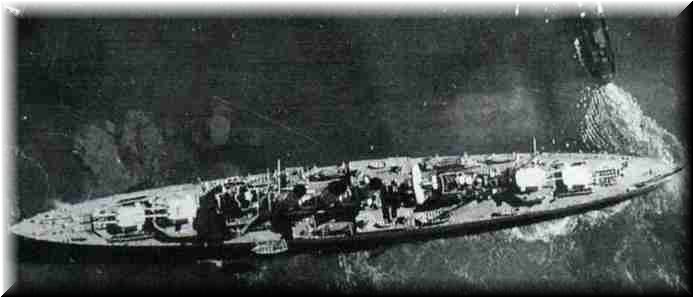[ Page 10 ] All the crew were rescued, except for two members killed by gunfire during the attack.
Ruckteschell found out that his aircraft, after flying for 4 hours, had broken down, and this would untortunately be a permanent situation, leaving him without any air reconnaissance. The importance of an aircraft to a Raider Captain has already been noted.
A further mishap, "salt water in the intake valves" found "Widder" dead in the water. She remained stopped for 6 hours, whilst engine room staff toiled to deal with this problem. Mean time, Control in Germany had sent the news that a Norwegian steamer "Sticklestad" was expected to be in the vicinity, and Ruckteschell fumed whilst his ship wallowed listlessly in mid Atlantic, quite powerless to take advantage of this target.
No sooner had repairs been made when a ship, thought to be the Norwegian hove in sight. A shot was fired, which persuaded the ship to stop. It turned out to be another Norwegian, the tanker "Krossfonn" of 9,OOO tons, and in ballast. This ship was boarded and despatched to Brest, recently having fallen into German hands when the German army overwhelmed both the French and British Armies.
"Krossfonn" had her tanks filled with water to give the appearance of an oil laden tanker proceeding to Europe. A tanker with a silhouette of one in ballast proceeding eastward would be a very unlikely event, and one to alert any Allied warship to have a close look at that phenomenon. She became the first prize ship to be brought into the port of Brest.
Two further British ships were encountered and then sunk, the "Davisian," 6,433 tons and the King John," 5,228 tons, the latter carrying survivors from the Panamanian ship "Santa Marguerita" which had been sunk by a U-Boat. It would be traumatic enough to be sunk by what ever means, (during the war, ! had been sunk by the Japanese Navy at the Battle of Savo Island, in the Solomons whilst serving as a young Sub Lieutenant in H.M.A.S. "Canberra."

H.M.A.S. Canberra about to berth in Melbourne, 1939-1940.
That had been full of drama, and a terrifying experience.) But, to he sunk, survive, be rescued, and then to be sunk a second time, would be most difficult to cope with, and to happen in the Atlantic Ocean, one of the meanest stretches of water to be found anywhere, is almost too much for a sailor to endure.
Now, 'Widder" was totally crowded. 100 prisoners taxed all available space, so her Captain immediately solved this problem by bundling all prisoners with the exception of the Captain and Chief Engineer from the "King John," plus 7 wounded men, into boats and suggesting they should shape a course for the lesser Antilles, about 240 miles away
When attacked, "King John" had sent off an SOS message by radio. The Germans were delighted to learn from some prisoners that an error of some 150 miles had been made in the stated position they had given.
Mid July found "Widder" asking their home base for supplies. They were informed that the tanker 'Rekum" would meet them in 14 day's time. The French Cruiser "Jeanne d'Arc" reported that 41 survivors from "Davisian" and 'King John" had anrived at Anguilla, repotting for the first time the presence of a German Armed Raider operating in mid Atlantic. The Admiralty alerted 2 County Class Cruisers, 5 Armed Merchant Cruisers, plus a Sloop to be on the lookout for the "Widder," but she evaded this drag net, and remained operational.



This site was created as a resource for educational use and the promotion of historical awareness of the Gustloff and associated events. All rights of publicity of the individuals named herein are expressly reserved, and, should be respected consistent with the reverence in which this memorial site was established.
Copyright © 1984/1999 Computrain All rights reserved
